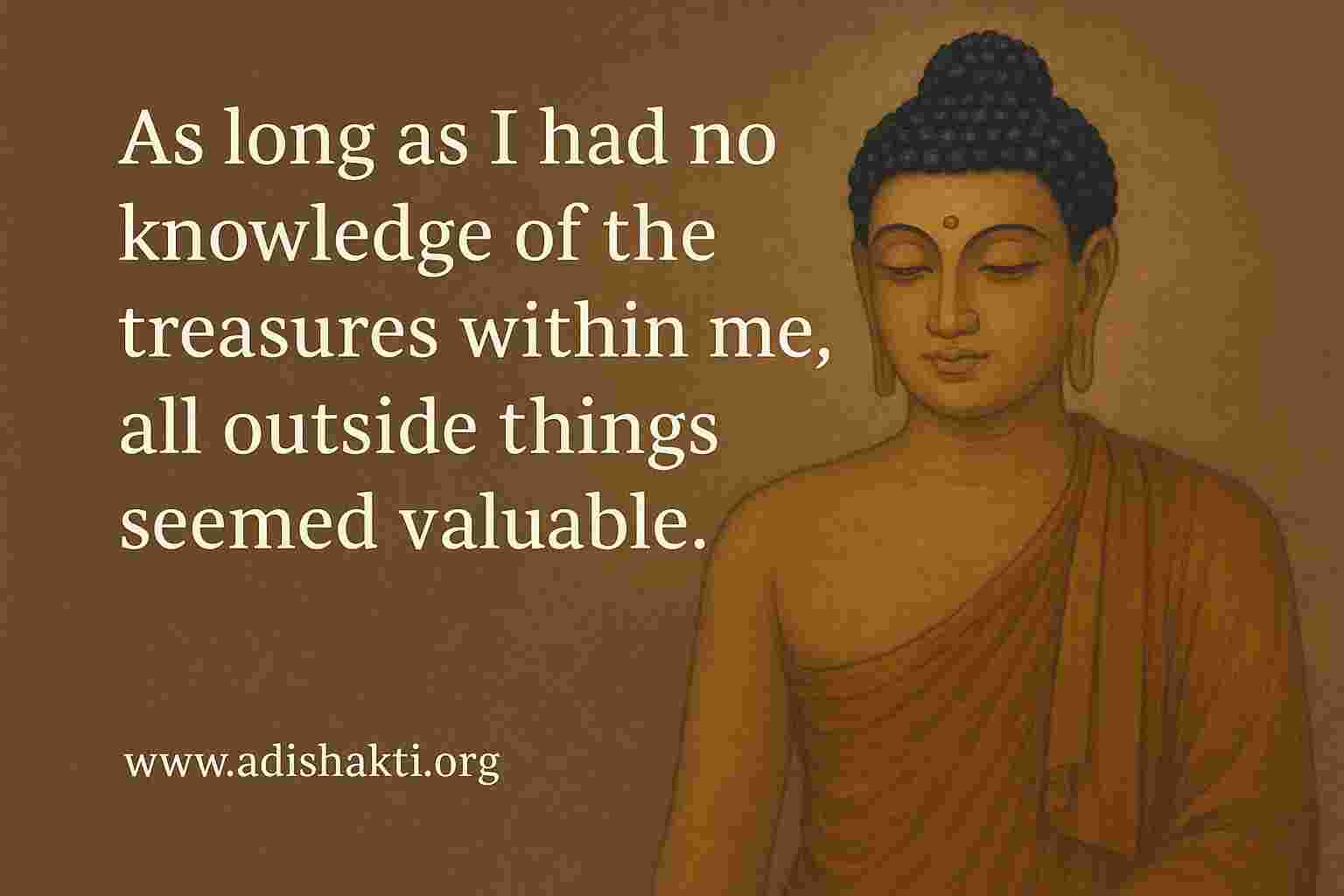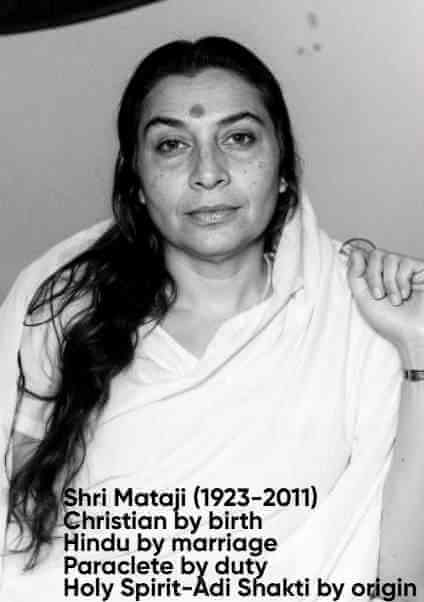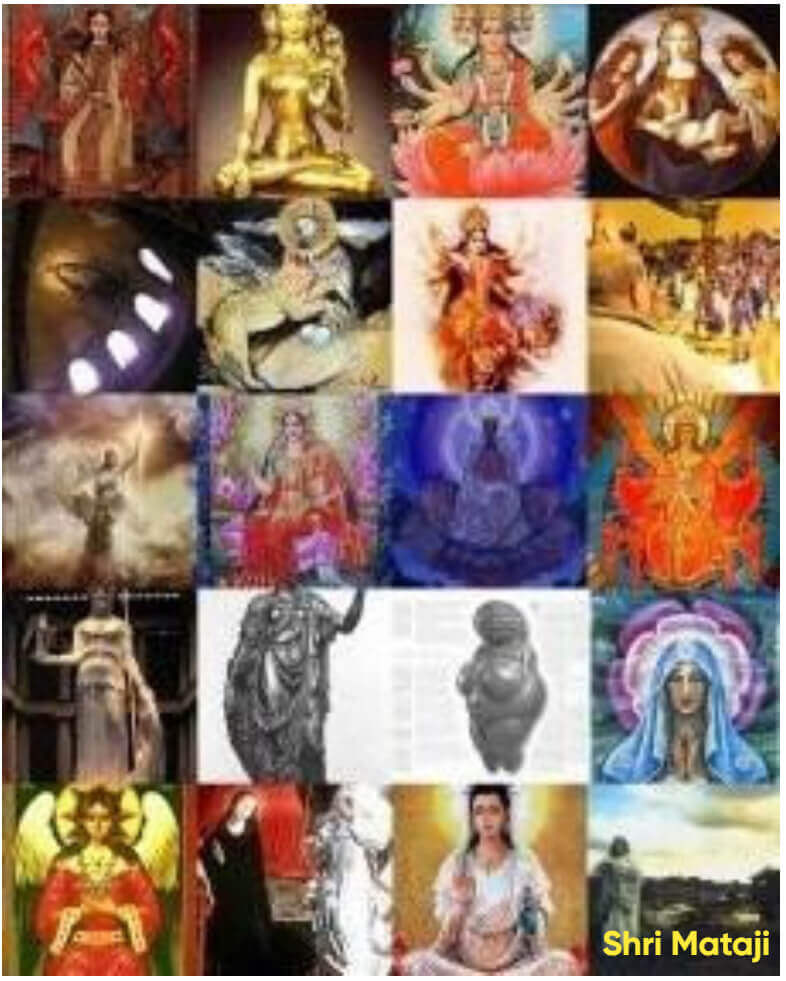Buddha: As Long As I Had No Knowledge of the Treasures Within Me
The Buddha’s awakening was not a discovery of external truths, but a realization of the divine treasures already within. His words echo the eternal truth proclaimed by Shri Mataji Nirmala Devi: the Kingdom of God lies within. Through Sahasrara awakening and Kundalini realization, seekers experience the same inner light that Buddha described. This article affirms that Self-Realization is not a doctrine—it is a direct encounter with the Divine. The treasures are within. The path is open. The Spirit is here.

"What exists in truth is the Self alone. The self is that where there is absolutely no "I" thought. That is called Silence. The Self itself is the world; the Self itself is "I"; the Self itself is God.” The inner silence is self-surrender. And that is living without the sense of ego. Solitude is in the mind of humanity. Silence is ever speaking; it is the perennial flow of "language.” It is interrupted by speaking; for words obstruct this mute language. Silence is permanent and benefits the whole of humanity... By silence, eloquence is meant. It is the best language. There is a state when words cease and silence prevails.” Ramana Maharshi
In an era saturated with noise—digital distractions, urban clamor, and the relentless chatter of the mind—silence emerges as a sacred refuge, a portal to inner transformation. Both Gautama Buddha and Shri Mataji Nirmala Devi, the founder of Sahaja Yoga, illuminate silence not as mere absence but as a vibrant force unveiling the truth within. At the heart of this exploration lies a statement attributed to Buddha:
“As long as I had no knowledge of the treasures within me, all outside things seemed valuable. Now since I have found the diamond within, all earthly diamonds have paled into insignificance.”Complementing this, Shri Mataji’s teachings, drawn from Nirmala Vidya Amruta, emphasize silence as the key to self-realization and inner peace. By weaving their insights together, we uncover silence as the alchemist that transforms the ordinary into the divine, guiding us to the treasure within.
The Silent Sage: Buddha’s Path to Enlightenment
Born around 563 B.C., Buddha—revered as Sakyamuni, the "gracefully silent one of the Sakya clan"—chose stillness over intellectual debates prevalent in his time. The Indian term mauna encapsulates this silence, signifying blissful calmness, joyous recollection, and tranquil quietude. Legends portray Buddha as a serene sage whose eloquent silence transcended words, a medium through which truth flowed undistorted. In a classic anecdote, a philosopher asked,
“Without words, without the wordless, will you tell me the truth?”Buddha’s silent response dissolved the philosopher’s delusions, prompting gratitude and recognition of the "true path." Buddha likened him to "a good horse that runs even at the shadow of the whip," illustrating silence’s power to awaken truth.
This silence, integral to Buddhist schools like Theravada, Mahayana, and Zen, is the catalyst for dhyana (meditation). For Buddha, truth (satya), rooted in "being" and "existence," was inseparable from silence. Attempts to articulate it risked falsification, as silence itself embodied truth’s essence—a sacramental communion of being rather than knowledge. His presence radiated this mauna, transforming seekers without utterance, like invisible waves permeating the atmosphere.
Shri Mataji’s Vision of Silence: The Doorway to Self-Realization
Shri Mataji Nirmala Devi, the founder of Sahaja Yoga, echoes this reverence for silence, framing it as the cornerstone of spiritual awakening. In a 1985 talk in Melbourne, she stated,
“You have to know your Self, because it’s only the Self that is the thing which gives you the joy, which gives you the silence, which gives you the peace.”(Nirmala Vidya Amruta, 1985) This aligns with Buddha’s insight, emphasizing silence as the state where the self is discovered, free from external clamor. For Shri Mataji, silence is not passive but dynamic, a space where the Kundalini energy rises, leading to self-realization—a spontaneous awakening akin to Buddha’s enlightenment.
In a 1988 address in Ganapatipule, Shri Mataji elaborated,
“You have to become thoughtlessly aware, where you are silent completely. That is the point where you become one with the Divine, and then the Divine starts flowing through you.”(Nirmala Vidya Amruta, 1988) This mirrors Buddha’s mauna, where silence is not an absence but a vibrant unity with the divine, radiating peace and joy. Shri Mataji’s Sahaja Yoga teaches that silence allows one to transcend thought, accessing a state of “thoughtless awareness” where the inner diamond—the self—shines forth.
Distinguishing Silences: From Turmoil to Tranquility
Not all silences are transformative. The “unquiet silence” familiar to many is a facade—externally calm but internally chaotic, filled with thoughts, desires, and conflicts. It shatters easily, breeding irritation. “Speechless silence,” induced by shock or fear, is equally fleeting, amplifying anxiety without offering peace.
Buddha’s and Shri Mataji’s silence, however, is a “tranquil silence”—natural, spontaneous, and radiant. For Buddha, it arose from inner harmony, aligning the seven layers of consciousness to dispel rational illusions. Early Buddhist art captures this in serene statues, exuding stillness that invites contemplation. Similarly, Shri Mataji described silence as a state of inner integration:
“When you become silent within, you are completely integrated, and you enjoy the bliss of your Spirit.”(Nirmala Vidya Amruta) This silence, pulsating with energy, transforms those in its presence, fostering a profound connection with the divine.
Emptiness as the Gateway: Unveiling the Inner Diamond
Buddha’s path to silence involved sunyata—emptiness as openness and freedom. The story of Subhuti, showered with flowers by gods for his unspoken discourse on emptiness, underscores this. True emptiness dissolves subject-object dualities, allowing silence to flourish. Buddha’s attributed statement,
“As long as I had no knowledge of the treasures within me, all outside things seemed valuable. Now since I have found the diamond within, all earthly diamonds have paled into insignificance,”captures this shift. External pursuits lose allure when the inner self is discovered through silent contemplation.
Shri Mataji’s teachings resonate deeply here. In a 1990 talk, she said,
“Silence is the only way you can really go into the depth of your being, where you find the source of joy, the source of peace.”(Nirmala Vidya Amruta, 1990) Like Buddha’s sunyata, her approach requires shedding desires and ego, accessing the “source” within—the inner diamond. This emptiness is not negation but a fullness that reveals the self’s eternal value, rendering worldly attachments insignificant.
Silence in a Noisy World: A Call to Inner Reconciliation
Today’s world, dominated by external noise, amplifies the need for silence. The rise of meditation centers and ashrams reflects a universal longing for inner truth. Mahatma Gandhi’s mauna viradha—weekly silent fasting—mirrored this, resolving inner conflicts to fuel his satyagraha (insistence on truth). Shri Mataji, too, emphasized silence’s practical role:
“In silence, you can feel your own vibrations, your own Spirit, and that’s how you grow spiritually.”(Nirmala Vidya Amruta)
Buddha’s and Shri Mataji’s teachings converge on silence as the path to the inner diamond. For Buddha, it was the medium of enlightenment; for Shri Mataji, it was the doorway to self-realization. Both reveal that external treasures pale when the self’s radiance is uncovered. In embracing silence, we transcend noise, reconnect with our core, and discover the divine within. As Shri Mataji poignantly stated,
“Silence is the language of the Spirit, and in that silence, you meet God.”(Nirmala Vidya Amruta) In this sacred stillness, the universe unveils its secrets, guiding us, like Buddha’s good horse, toward the eternal truth at the mere shadow of wisdom.


